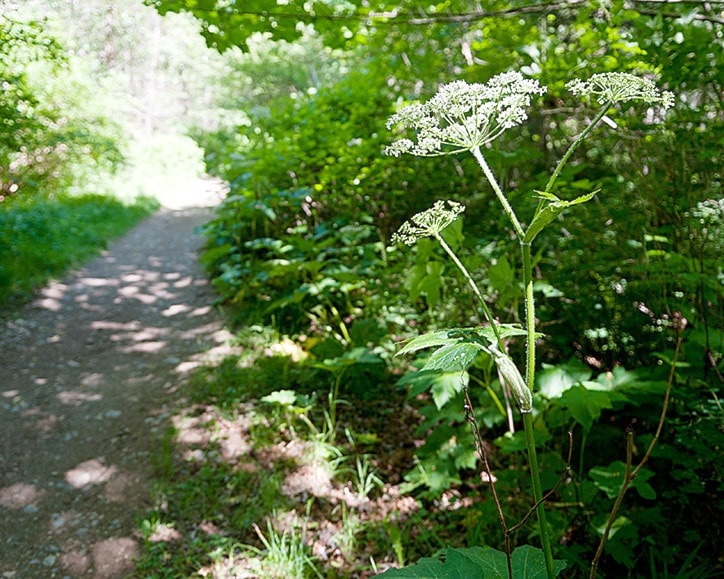An infestation of plants along the Oyster River that drew the concern of area residents are not the toxic giant hogweed, the Coastal Invasive Species Council confirmed Wedneday.
Rather, they are native cow parsnip, a close relative of the hogweed that resembles its more noxious cousin, but grows to only about half the size.
After a report of sightings of the plant appeared in the Mirror May 27, the Ministry of Forests, Lands and Natural Resources contactd the Coastal Invasive Species Council, which serves the Vancouver Island region. Field staffer Ernie Sellintin visited the area Wednesday and confirmed the plants, which appear in some profusion along trails on a private forestry property, were all cow parsnip.
One of the property's owners also made an independent visit to the site to determine if removal of the plants would be neccesary, and also determined, after comparing them with images of giant hogweed, that they were cow parnip.
Bruce and Heidi Giles grew concerned after hearing a report last summer from an Oyster River Hatchery volunteer that giant hogweed had appeared in the area. A single plant sprouted last summer in the road right-of-way across from their home, and a profusion of them have grown along the trails in the private forestry area, which are accessed by hikers.
"We never saw it back there until last summer," Heidi Giles said. "Now it's everywhere."
Becky Brown, invasive plant specialist with the Ministry of Forests, Lands and Natural Resource Operations, said the ministry takes seriously reports of giant hogweed, due to its public health risk, and catalogues confirmed incidents in a provincial database.
“It’s been a known problem in Southwest B.C. for, I would say, the last 10 years, at least,” said Brown. “That’s when it really came on our radar. Due to the potential health impacts, it tends to be dealt with quite aggressively.”
The primary difference between giant hogweed and cow parsnip is simply its size. Giant hogweed can reach heights of 4-5 metres (12-16 feet) by the time it reaches its flowering stage. Cow parsnip is roughly half as tall.
Both plants produce a crown of small, white flowers in an umbrel, and, again, the giant hogweed umbrels tend to be larger across. Finally, both plants boast large, palmate leaves, but the giant hogweed leaves — which can reach up to a metre in diametre, tend to be more jaggedly serrated than their cousins'.
Giant hogweed is dangerous because the poisonous sap produced in its leaves and stems can cause severe irritation, burns and blistering when it contacts exposed skin.
Perhaps most insidious, the sap sensitizes skin to ultraviolet radiation, meaning the site of the contact can continue to burn for several years afterward, each time it is exposed to sunlight.
In severe cases, permanent scars can result, and if the sap comes in contact with the eyes it can cause temporary or even permanent blindness.
Different people may have varying degrees of reaction depending on their DNA makeup and the amount of sap, and even cow parsnip can cause photosensitive reaction and blistering, though the amount of poison in its sap if much lower.
Because of the plant’s risk to public health, both the province and Strathcona Regional District have management plans in place to remove the plants from parks and lands under their control.
Last month, the province awarded $1.7 million in grants to 29 organizations to perform invasive species management in B.C. A portion of that funding went to the Coastal Invasive Species Committee, which serves Vancouver Island, the Gulf Islands and the Sunshine Coast.
The province also provides management information for private owners who wish to control giant hogweed and other invasive plants on their own land.
A video is available from Worksafe BC, and information is available online from the Invasive Species Council and the BC Ministry of Agriculture.
Anyone who believes they have located a giant hogweed plant are encouraged to report it to the Invasive Species Council of BC's hotline at 1-888-WEEDSBC, or to the Coastal Invasive Species Committee hotline at 250-857-2472. Additional info is available at www.coastalisc.com.
